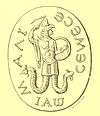Second Apocalypse of James
| Part of a series on | |||
| Gnosticism | |||
|---|---|---|---|
 | |||
| History | |||
| Proto-Gnostics | |||
| Scriptures | |||
|
|||
| Lists | |||
| Related articles | |||
The Second Apocalypse of James is an apocalyptic text of the Nag Hammadi library, and it is the fourth tractate placed right after the First Apocalypse of James of what is now known as Codex V.[1] The text accounts of the trial and martyrdom of James the Just. It is believed to have been written around the 2nd century CE, and then buried and lost until it was re-discovered amongst 52 other Gnostic Christian texts spread over 13 Codices by an Arab peasant, Mohammad Ali al-Samman, in the Egyptian town of Nag Hammadi late in December 1945.
The gnostic text contains many Jewish-Christian themes, making many scholars think it to be one of the earlier texts, originally from the early or mid 2nd century. One of the most curious features of the second apocalypse of James is that this range of dating, of its original text, assigned to it by scholars, requires that it was written before the First Apocalypse of James.
There are a number of differences with the more canonical history that the text describes. For example, it names James' father Theudas rather than Joseph, who is presented as the biological father of James by the mid 2nd century Protevangelium of James. The wife of this Theudas is named Mary, but whether this Mary is the same woman as the mother of Jesus, or whether this wife of Theudas named Mary is supposed to be the biological mother of James, is not clear from the text. The First Apocalypse of James explicitly claims that James and Jesus are not biological brothers.
The text features a kiss between James and Jesus, on the lips, in a similar manner to the way in which Jesus is said to have kissed Mary Magdalene in other gnostic texts (which lent credence to the idea that early tradition considered Mary to be the Beloved Disciple).
- And Jesus kissed my mouth. He took hold of me saying: 'My beloved! Behold, I shall reveal to you those things that the heavens nor the angels have known. Behold, I shall reveal to you everything, my beloved. Behold, I shall reveal to you what is hidden. But now, stretch out your hand. Now, take hold of me'.
However, the text also describes how such a kiss was a metaphor for the passing of gnosis, explaining the references to it elsewhere, making it clear that this isn't the homosexual relationship it appears to be.
The text ends with the rather gruesome death of James by stoning, possibly reflecting an early oral tradition of what became of James:
- They decided to throw him down from the height, and they cast him down... They seized him and struck him as they dragged him on the ground. They stretched him out and placed a stone on his abdomen. They all placed their feet on him, saying: 'You have erred!' Again they raised him up, since he was alive, and made him dig a hole. They made him stand in it. After having covered him up to his abdomen, they stoned him.
References
- ↑ Brown, S. Kent (July 1975). Novum Testamentum Vol. 17, Fasc. 3. Provo, Utah: BRILL. pp. 225–237.